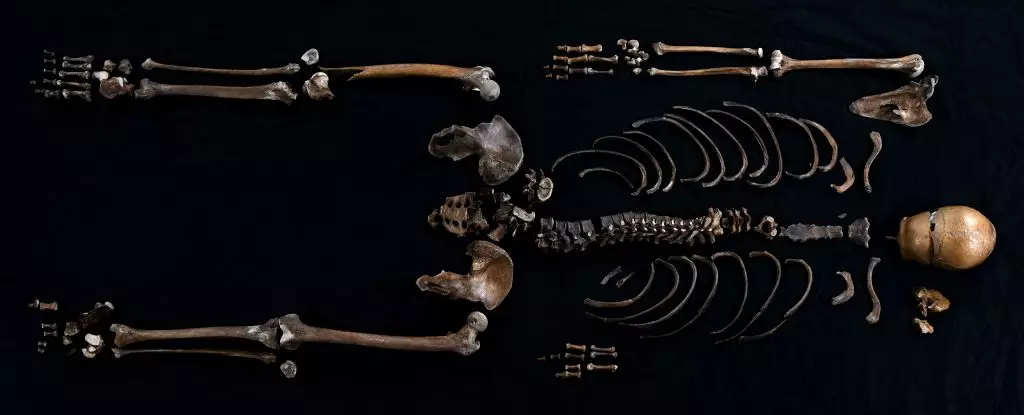In the grand tapestry of history, the Viking Age and its aftermath are often gilded with dramatic tales of battles, conquests, and power struggles. Among these stories is that of King Sverre Sigurdsson, a pivotal figure in Norwegian history, who ruled from 1184 to 1202 CE. A remarkable mention in the Sverris Saga—a narrative chronicling his reign—paints an image of a conflict-laden era. It recounts an event in 1197 where a dead man was thrown into a well by enemy forces, an act aimed at polluting the water supply. This seemingly minor detail has transformed into an intriguing archaeological investigation, particularly as a team of scientists delved into the mystery surrounding the so-called “Well Man.” Through advanced genomic analysis, evidence has arisen that connects the historical narrative with tangible human remains.
The bones in question were discovered in 1938 at Sverresborg Castle, situated in central Norway. However, the knowledge gleaned at that time was limited to rudimentary osteological research. Fast forward to today, and developments in genomic science have opened new avenues for exploration. Under the leadership of Martin Ellegaard from the Norwegian University of Science and Technology, researchers have embarked on a quest to extract every possible detail from the Well Man’s remains.
Historically, the linkage between remains and literary accounts has often been fraught with challenges. Yet, this case stands out as the first documentation from a saga that has been tied to real archaeological evidence. The researchers employed radiocarbon dating, gene sequencing, and isotope analysis to assemble the life story of an individual whose timeline coincided with the turmoil of Sverre’s reign.
The preliminary findings from the genomic investigations have revealed vital aspects about the Well Man. Radiocarbon dating places his death around the time of the conflict, around the late 12th century, supporting the timeline described in the saga. Genomic analysis indicates that the man likely had distinct physical traits—blond or light brown hair and blue eyes—adding a personal layer to his previously anonymous existence.
Perhaps one of the most significant realizations is the potential geographical origins of the Well Man. Analyses direct his roots to Vest-Agder, the southernmost county in Norway—a considerable distance from Trondheim. This geographical insight not only sheds light on the movement of people during the medieval era but also strengthens the narrative’s historical authenticity.
An essential aspect of understanding an individual from this period is deciphering their lifestyle and dietary habits. Isotope analysis further enriches our knowledge of the Well Man’s life. The findings suggest a diet heavily reliant on seafood, indicating a coastal existence. This detail may provide an important context regarding trade, fishing practices, and social structures in 12th-century Norway.
Although the specifics of his demise remain shrouded in mystery—his identity as either a victim in battle or a casualty of a larger power play—there is a tantalizing possibility that he may have been a Bagler, the faction that had invaded Sverresborg Castle. The saga’s narrative does not present a bloodless account; nonetheless, it leaves numerous threads hanging regarding the true nature of this incident.
Engaging with the past is seldom a straightforward endeavor. While the Sverris Saga provides a linear storyline, modern archaeological findings challenge and refine these tales. According to Anna Petersén, an archaeologist engaged in this research, the convergence of historical written records and contemporary genomic studies underscores the complexities of historical representation. As our understanding grows, the narratives that have long been accepted require reevaluation and, in some cases, recontextualization.
The Well Man’s story stands as a testament to how genomic databases and meticulous historical research can bridge gaps in our understanding of history. Each step forward in analysis opens further questions and insights. This ongoing exploration cultivates an appreciation for the profound interconnections between the past and present, and how science can illuminate even the darkest corners of history.
The investigation into the Well Man not only enriches our comprehension of Norse history but also exemplifies the power of interdisciplinary collaboration. By merging literature, archaeology, and genomic science, we are afforded a more nuanced perspective of our shared past. The legacy of the Well Man transcends his tragic end in a well, symbolizing humanity’s unyielding quest for knowledge and understanding about those who came before us. As researchers unravel these secrets, we not only learn about their lives but also about the intricate tapestry of our own existence.


Leave a Reply